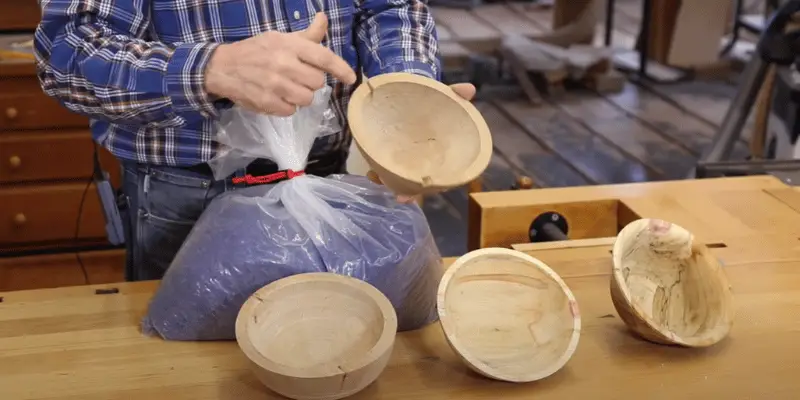No, wood should not go in the microwave as it can catch fire. It’s essential to avoid putting wood in the microwave to prevent the risk of fire and damage to the appliance.
While the microwave may seem like a convenient tool for heating or cooking various materials, such as food and certain types of containers, wood is not safe for use in this appliance. Understanding the limitations of what can be safely microwaved is important for maintaining the safety and functionality of your microwave.
In the following article, we’ll explore the reasons why wood should not be microwaved, the potential hazards of doing so, and alternative methods for heating or treating wood products. By the end, you’ll have a clear understanding of why wood and microwave appliances should not be combined.
Understanding The Potential Risks
When it comes to using a microwave oven, it’s essential to be cautious about the materials placed inside. Wood is a commonly used material in kitchen utensils and implements, but can you put wood in the microwave? Understanding the potential risks associated with this practice is crucial to ensuring the safety of both the microwave and the user.
Moisture Content And Combustion
Wood, as a natural material, contains moisture. When exposed to high temperatures such as those in a microwave oven, the moisture within the wood can evaporate rapidly, leading to a risk of combustion. This is particularly true for types of wood with higher moisture content, which can pose a significant fire hazard when subjected to the extreme heat of a microwave. Placing moist or wet wood in the microwave can increase the likelihood of combustion as the water pockets within the wood rapidly turn to steam under the intense heat.
Release Of Harmful Chemicals
Another potential risk of putting wood in the microwave is the release of harmful chemicals. When wood is subjected to high temperatures, it can potentially emit volatile organic compounds (VOCs) and other toxins into the air. This can not only affect the flavor and aroma of the food being heated but also poses health risks to individuals inhaling these harmful substances. High heat can cause the breakdown of certain compounds found in wood, leading to the release of toxic fumes that can be damaging to respiratory health.
Can Wood Safely Go In The Microwave?
When it comes to using a microwave, there are many considerations about what materials can or cannot be safely heated within it. One common question that arises is whether wood can be placed in the microwave. Let’s delve into the factors that determine whether wood can safely go in the microwave and the potential hazards associated with it.
Safety Tips For Microwaving Wood
When it comes to microwaving wood, it’s important to follow safety guidelines to prevent any potential hazards. Safety Tips for Microwaving Wood are crucial in ensuring that the process is not only effective but also safe for both the wood and the microwave. Here are some essential safety tips to keep in mind when microwaving wood.
Proper Wood Selection
When choosing wood to microwave, it’s essential to select wood that is suitable for the microwave. Certain types of wood, such as untreated or unpainted wood, are generally safe for microwaving. Hardwoods like oak, maple, and cherry are typically suitable, while softwoods like pine or cedar may not be the best choice due to their resin content, which can cause sparking or fire hazards in the microwave. It’s vital to ensure that the wood is clean and free from any contaminants that could potentially pose a risk when microwaved.
Preparing Wood For Microwaving
Before microwaving wood, it’s essential to prepare it appropriately to minimize any potential risks. Cut the wood into small, evenly sized pieces to promote even heating and reduce the risk of overheating. Sand the wood to remove any rough surfaces or splinters that could cause it to heat unevenly or pose a safety hazard. Additionally, moistening the wood slightly can help prevent it from drying out and potentially catching fire in the microwave. It’s also important to check for any metal fasteners or hardware, as these can cause arcing and damage to the microwave.

Alternatives To Microwaving Wood
Microwaving wood is often considered a quick and convenient method for drying and sterilizing wood, but it’s not the only option. There are a few alternative methods that can effectively dry wood without the use of a microwave. Let’s explore some alternatives to microwaving wood that can yield similar results.
Oven Drying Method
Using an oven is a great alternative to microwaving wood, especially for smaller wood pieces. Here’s a simple process to oven dry wood:
- Preheat the oven to the lowest possible temperature, typically around 200 degrees Fahrenheit.
- Cut the wood into smaller, manageable pieces to fit in the oven.
- Place the wood pieces on a wire rack or tray to allow for air circulation.
- Let the wood pieces dry in the oven for several hours, occasionally checking for dryness.
- Once dry, remove the wood from the oven and let it cool before handling.
Using A Food Dehydrator
A food dehydrator can also be used as an alternative to microwaving wood. Here’s how you can use a food dehydrator to dry wood:
- Select a food dehydrator with temperature control settings.
- Cut the wood into smaller pieces that fit inside the dehydrator trays.
- Place the wood pieces in the dehydrator trays, ensuring there is space between each piece for proper drying.
- Set the dehydrator to a low temperature, around 100 to 140 degrees Fahrenheit, and let the wood dry for several hours or until it reaches the desired dryness.
- Once dry, remove the wood pieces from the dehydrator and let them cool before use.
Conclusion And Best Practices
When it comes to using wood in the microwave, it’s essential to be aware of the potential risks and best practices to ensure safety. In this section, we will recap the safety tips and share final thoughts on using wood in microwaves.
Recap Of Safety Tips
Before you consider using wood in the microwave, it’s crucial to remember the following safety tips:
- Use only microwave-safe wood products to avoid the risk of fire or damage to the microwave.
- Avoid using wood that contains glue, adhesives, or any non-microwave-safe materials.
- Keep the wood product dry and free from moisture to reduce the risk of steam buildup and potential damage to the microwave.
- Monitor the wood closely while microwaving to detect any signs of charring, smoking, or overheating.
- Always follow the manufacturer’s instructions and recommendations for using wood in the microwave.
Final Thoughts On Wood And Microwaves
Considering the potential risks associated with using wood in the microwave, it’s generally advisable to avoid microwaving wood products. While some microwave-safe wood items may be suitable for brief or low-power heating, it’s essential to proceed with caution and closely monitor the process to prevent accidents or damage.
Frequently Asked Questions Of Can Wood Go In The Microwave
Can You Put Microwave On Wood?
Yes, you can place a microwave on a wood surface as long as the wood is sturdy and can support the weight of the appliance. It is important to ensure proper ventilation and avoid placing the microwave directly on polished or painted wood.
Can I Put A Wood Cutting Board In The Microwave?
No, you should never put a wood cutting board in the microwave. Wood can dry out, crack, and even catch fire when exposed to high heat. It’s best to use other microwave-safe materials like glass or ceramic for heating food.
Can A Wooden Spoon Go In The Microwave?
No, wooden spoons should not be used in the microwave as they can dry out and crack.
Can I Microwave Wooden Bowl?
Microwaving wooden bowls is not safe as it can cause the wood to dry out, crack, or catch fire. It’s best to avoid microwaving wooden bowls to prevent damage and potential safety hazards. Consider using microwave-safe alternatives like glass or ceramic bowls.
Conclusion
In short, avoid putting wood in the microwave to prevent potential hazards. Always prioritize safety when it comes to using kitchen appliances. If you need to use wood in cooking, opt for utensils specifically designed for microwave use. Stay informed and cautious to maintain a safe and efficient kitchen environment.


